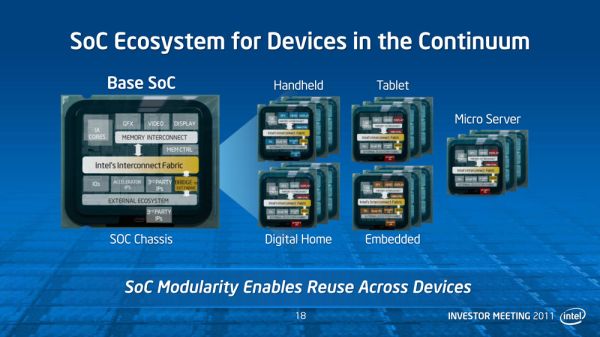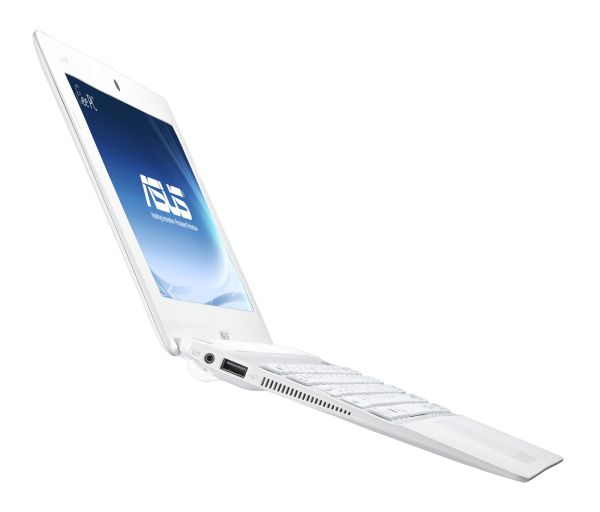The Ultrabook: Meet the New Thin and Light Intel Notebook
by Anand Lal Shimpi on May 31, 2011 12:01 AM EST- Posted in
- Laptops
- CPUs
- Intel
- Atom
- Haswell
- Computex 2011
- Trade Shows
- Ultrabook
Where Does This Leave Atom?
When Haswell hits in 2013, Intel will also update the Atom line to introduce the recently announced Silvermont architecture. As I speculated publicly before, based on Intel's hint to me five years ago that Atom would remain in-order for five years, I'm expecting Silvermont to be Intel's first Out-of-Order Atom.

When Atom was introduced, its microprocessor architecture was unlike anything we'd seen from Intel in years. It looked more like a modern take on the Pentium rather than a P6/Conroe derivative. That was nearly five years ago, so what do we expect Silvermont to look like? I'd say it might look a lot like a modern, ultra low power take on Conroe. Perhaps a limited Out-of-Order execution core, only a 3-wide front end and a number of other limitations to keep its power in check.
In the sub-10W range Intel is going to use Atom specifically for fanless designs - the next generation of netbooks as well as tablets. Cedar Trail is Intel's 32nm Atom platform which we've talked about already, which will be used in netbooks such as ASUS' newly announced EeePC X101:
Medfield is the ultra mobile version of Atom, destined for handsets and tablets, and at the show we should finally see a Honeycomb (Android 3.0) tablet running the SoC. Unfortunately with NVIDIA Tegra 2 based tablets moving to Android 3.1 already, and Medfield designs not due out until later this year I'm wondering if that may be too little too late.

Expect more coverage on Intel's announcements at the show as we come by them.















33 Comments
View All Comments
OS - Tuesday, May 31, 2011 - link
heh i am hardly a mac fanboy, but i take this as intel basically saying half the future laptops should look like a macbook airPenti - Tuesday, May 31, 2011 - link
Well ultra portables are nothing new, but they are consumer friendly with pricing now. I.e. a laptop with a ULV processor doesn't cost over 2000 dollars any more. Which on the low end Apple was late getting on. CULV and consumer ultra-portables was already there by then. It's Intel that is responsible for all that as they provided the hardware platform for it to happen. A ULV-processor could before just a few years ago almost cost more then a CULV-laptop. Now they can be had for 100 USD. Performing not that badly. Falls in line with their "consumerising" of PCs.kevith - Tuesday, May 31, 2011 - link
Is this a way to solve the input-problem with tablets?You could have one of these new ultrathin ultrabooks, and - like some clam-type phones - have a screen on the outside for pad-use, where you could use swype or normal touch.screen input.
And then you could open it and have a normal keyboard and screen on the inside for more demanding work.
TEAMSWITCHER - Tuesday, May 31, 2011 - link
When Steve Jobs unveiled the MacBook Air last year he said that it's design was a prelude to future MacBooks. Now Intel says the future of the PC is ultra-thin notebooks. Hmmm...sstteevveenn - Tuesday, May 31, 2011 - link
roadmap [s]going forward[/s]mino - Tuesday, May 31, 2011 - link
Anyone else wondering when are the new "Hyperbooks" due?/sarcasm
tipoo - Tuesday, May 31, 2011 - link
"Atom will service a new expanded range from ~800mW to 8W"The Cortex A9 cores (each) draw 250mW at load. Still a ways to go for Intel, but if a single one of those 800mW cores can beat both Cortex A9 cores in performance that's competitive.
name99 - Tuesday, May 31, 2011 - link
"The first requirement of an Ultrabook is that it's ultra-thin. In Intel's eyes this means less than 0.8" (20.32mm) which is thinner than anything Apple offers in the MacBook Pro line (0.95")."So I guess that Intel (unlike a million screaming Apple haters) can see the writing on the wall. Optical storage is pointless for an ever larger group of users.
Let's see how long it takes for the story to switch from "but but but, how do you deal with not having a boot DVD" to "of course, Apple stole the idea of selling bootable USB sticks from MS/Linux/Nintendo/Atari".
frozentundra123456 - Wednesday, June 1, 2011 - link
I agree with Kevith. Seems to me like the ideal solution would be a combination of some tablet type screen that would then open up to allow you to use a keyboard.I would pay 1000.00 for something like this that you could use as a tablet and laptop combination. otherwise, I could not consider paying this much for a thin and light notebook. As someone else noted, i would prefer to buy a 500.00 tablet and a separate 500.00-700.00 laptop.
Shadowmaster625 - Wednesday, June 1, 2011 - link
Intel is obviously on a big money grab hoping their huge margins are going to carry them to the stars. Obviously they are delusional. All the idiot-trendy yuppie types who would actually pay the intel premium for a device like this are already buying Apple. lol. The non-ultrabook products will be significantly cheaper, thus they are what will sell, aside from the small % mindless yuppies who are already buying apple.